Some trees have extensive root systems and growth habits that defy your best efforts to kill them. Learn how to kill a tree stump for good with these effective techniques.
Why Killing Tree Stumps is Necessary
When homeowners remove trees from their property, the stump is sometimes an afterthought. While it doesn’t always matter if you have a stump on your property, sometimes it’s a problem. Learn why it’s best not to leave a tree stump in the ground.
Understanding the Problems with Tree Stumps
Leaving a tree stump in the ground can present significant challenges, especially if you have a small yard and the stump is in the way. Here are the most common problems people associate with tree stumps:
- They attract insects and pests.
- They won’t stop growing.
- They’re an eyesore.
- They present tripping hazards.
- They take up space.
Often, when developers clear land to make space for a building or new landscaping features, tree stumps are in the way. Naturally, crews have to remove them before construction can begin.
Benefits of Removing Tree Stumps
Even if you don’t need that stump removed immediately to make room for another project, removing tree stumps has several benefits.
Safety Reasons
One of the most significant problems with stumps is that they’re a safety hazard, and cutting them low to the ground doesn’t help. Safety hazards increase your liability as a homeowner and present hazards to your family.
Makes Yard Maintenance Easier
The fewer obstacles you have in your yard, the easier it is to maintain. Instead of spending time every week cutting the grass around a stump, why not take some time to remove it altogether?
Get your gear for less. Explore our guide to the Best Time to Buy Lawn Care Equipment!
Prevents Problems With Pests and Diseases
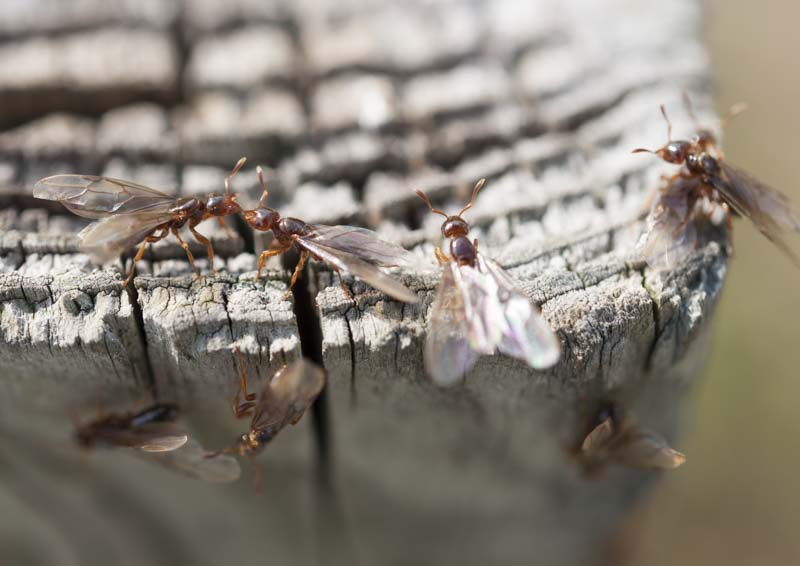
Stumps attract all sorts of organisms, including rodents, snakes, insects, and fungi, and it’s best to keep them out of your yard.
Aesthetics
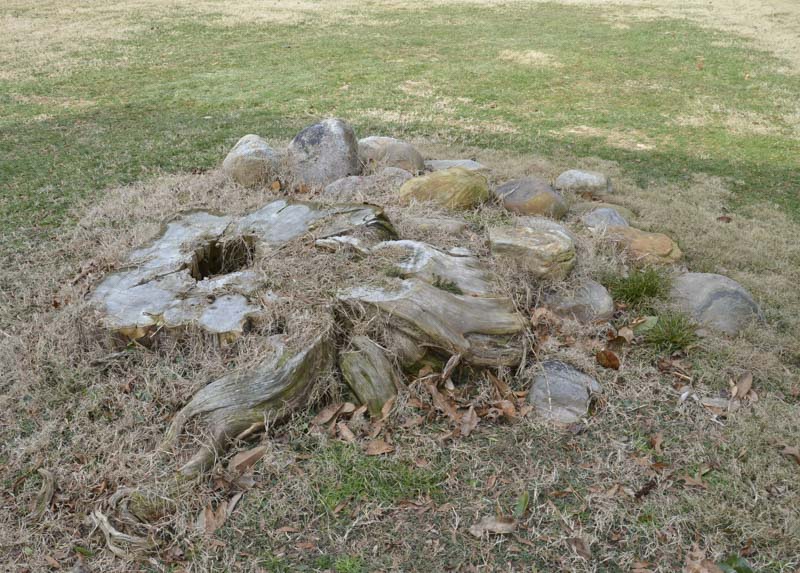

Everyone has seen a stump in someone’s front yard cleverly disguised as a flower pot holder. Nobody is fooled by the attempt to mask its presence. Removing a stump makes your yard look cleaner and enhances its visual appeal.
Regain Space
Until you remove that tree stump, you haven’t fully regained the space in your yard. As soon as it’s gone, you can do whatever you want in that area, whether it’s adding to your lawn or installing a flower bed.
Methods and Tips for Naturally Killing Tree Stumps
In some cases, allowing stumps to naturally decay is the easiest way to get rid of them. You can also use chemicals to kill tree stumps that won’t stop growing.
Chemical Decay Method
Tree stumps can be killed using various chemicals to stop the growth of sprouts and speed up the decay process. It may take up to 6 to 12 months to dissolve tree stumps using the chemical decay method, but once it’s partially decayed, it’s easier to dig it up and remove it.
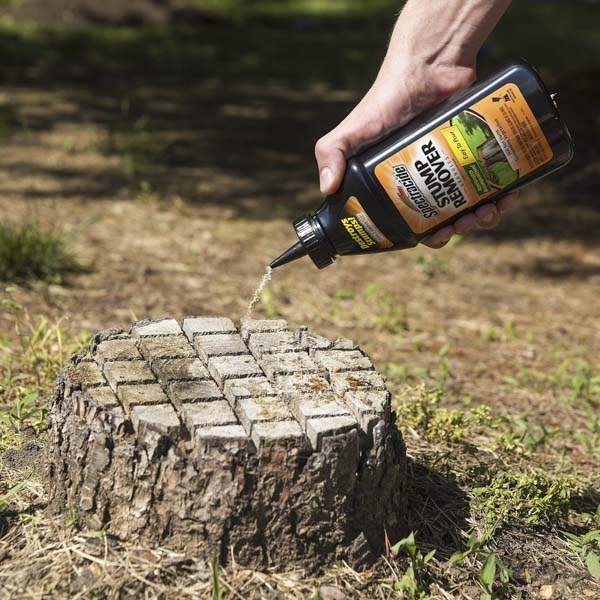

One common chemical to kill tree stumps is potassium nitrate, which is the active ingredient in Spectracide Stump Remover. It works well to make the tree roots porous, stop all growth, and accelerate decomposition.
To apply stump poison, drill holes into the tree stump about one inch in diameter and 12 inches deep. Pour the granules into the holes, then add water so the tree stump dissolver will soak into the wood. Cover it with a tarp and wait.
Epsom Salt Method
The best homemade stump killer is Epsom salt. It will stop new growth and kill stumps completely by drying out the roots.
Epsom salt, or magnesium sulfate, is a desiccant that kills vegetation, and it’s one of the most effective tree stump killers. By absorbing the stump’s moisture, it speeds up the decay process.
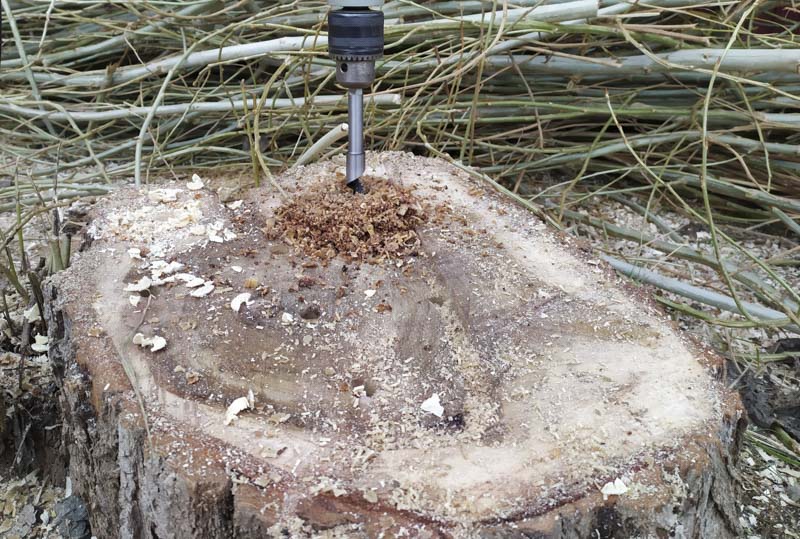

To use Epsom salt to kill tree stumps, employ the same technique you would use to apply chemical stump removers. Drill holes in the tree stump and fill them with Epsom salt, then add some water so it will soak in.
Since Epsom salt won’t harm the environment, salting tree stumps is completely safe, and you can add more to the stump every few weeks. This method will take about 6 to 12 months for the tree stump to decay.
Covering with Plastic
Another natural stump killer you can use is a piece of black plastic. Keeping out light and water effectively smothers the tree and kills it. Be sure to use a large enough piece of plastic to cover the entire stump, including the surrounding area where sprouts are trying to grow.
Cover the stump with straw mulch to encourage faster decay using this method. The organisms in the soil and mulch will work faster to decompose the stump, while the plastic smothers and kills the tree.
Methods and Tips for Forcibly Removing Tree Stumps
Some of the most effective means for removing tree stumps are physical methods, including stump grinding, excavation, and burning. If you need to remove a tree stump immediately, try one of these techniques.
If you’ve got trees to tackle, be sure to check out our extensive chainsaw coverage, including our Best Chainsaw Reviews and Best Battery Chainsaw Reviews lists.
Stump Grinding
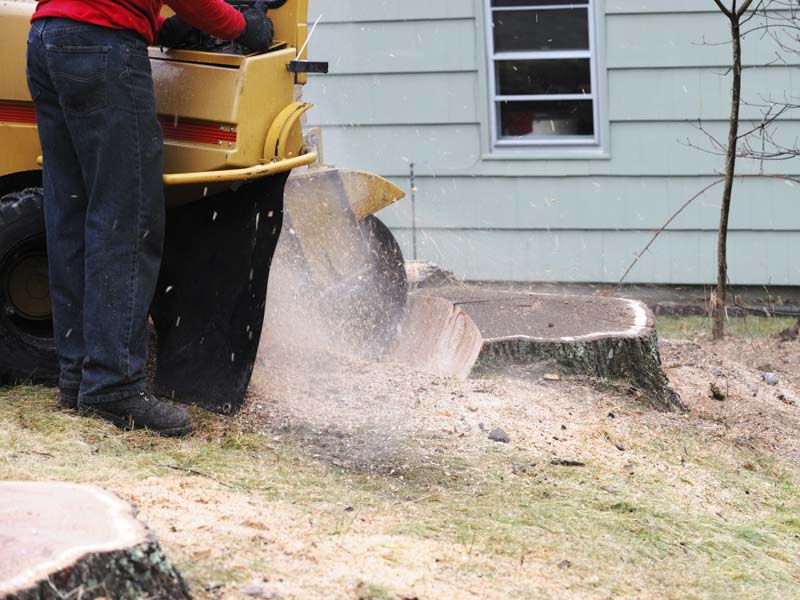

The fastest way to remove a tree stump is using a stump grinder. You can either hire a professional or rent a stump grinding machine to do it yourself. However, stump grinding machines are heavy equipment, and you must take proper safety precautions when using them.
The average cost of stump grinding depends on several factors, including the size of the stump and travel expenses, but it’s typically between $150 and $450. When you factor in the cost of renting the machine, hiring someone to remove the stump for you may be less expensive.
Stump Removal by Excavation
Excavating a tree stump takes longer than grinding, so it costs more to hire a professional, but it’s worth it if you need the entire stump removed. With excavation, you can kill the tree from its roots and remove it completely so you don’t continue to have problems with fungi growing on the organic matter in the soil.
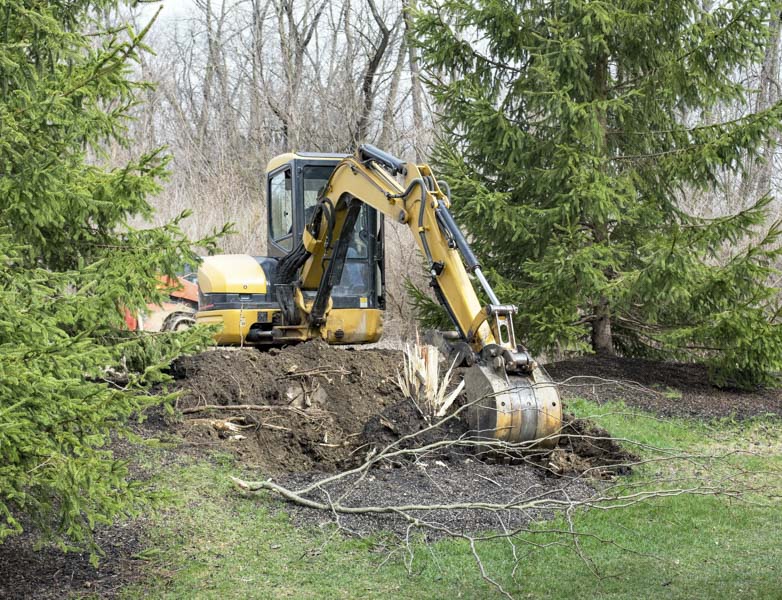

If you’re removing the stump to make room for something new, like installing a pond or laying a gravel pad to put a shed on, then excavating the stump is the best choice. It’s possible to excavate a stump yourself, but it can take several hours.
Start by digging a wide circle around the stump, cutting the roots away as you go with an axe or heavy-duty loppers. When you get down far enough, you can cut the tap root and pull the stump out with a truck or tractor. For large stumps, use caution because they can be heavy enough to cause injury during extraction.
Burning the Stump
Burning a stump is one of the easiest and fastest ways to get rid of it, but there are several safety precautions to consider. You must pay attention to burning restrictions in your area, and burning a stump requires careful monitoring to prevent the fire from spreading.
Follow these steps for best results when removing a stump using the burning method:
- Create a safe place to have a fire by digging around the stump. This also exposes more of the stump, so it burns better.
- Drill one-inch holes in the stump about 6 to 12 inches deep. Fill them with kerosene.
- Use kindling and firewood to build a fire on top of the stump.
- Take precautions when igniting the stump.
- Add more firewood as it burns and allow the fire to gradually consume the stump.
One major drawback to this method of stump killing is that you can’t use it near buildings or other trees.
When to Kill Tree Stumps
The timing of killing tree stumps depends on the tree species, your climate, and the method you choose to get rid of them. Learn more about timing considerations and assessing stump conditions before you start.
Timing Considerations
The best time to remove stumps depends on various factors, including your chosen method, local climate, and the tree species.
For chemical removal methods, it’s best to treat stumps as soon as the tree is cut down to stop growth immediately.
If you’re excavating them, you can remove stumps whenever the ground isn’t frozen. However, if you’re planting a new lawn after you remove the stump, spring is the best time.
If you’re burning the stump out, fall is the best time because it’s still nice outside, but the risk of fire danger is lower.
Assessing Stump Condition
The method you choose to remove a stump often depends on the condition of the stump. For example, partially decayed stumps are more difficult to grind. While it may be feasible to dig out a small stump, large stumps are extremely difficult to remove by excavation.
To properly assess the stump’s condition, consider the following factors:
- Stump size
- Root system
- Tree species
- Location
- Level of decay
- Accessibility
- Future land use
Additional Considerations When Killing Tree Stumps
Here are a few additional factors to consider when killing tree stumps in your yard.
Safety Precautions
Many of the methods used for stump removal present serious safety risks. Here are some of the most important safety precautions to consider when removing stumps:
- Secure work area–ensure that bystanders, especially small children, are outside your work zone.
- Safety gear–always use protective gear when handling hazardous materials or using equipment.
- Check for utilities–call 811 before digging to avoid the risk of injury or damage to equipment.
- Fire safety measures–adhere to burning restrictions and obtain permits when necessary.
- Stabilize equipment–stump grinders should be stabilized properly during operation.
- First aid–always have first aid supplies readily available.
Legal and Environmental Regulations
In some municipalities, you need a permit for tree and stump removal. Verify with local and state offices to determine if one is required in your area. You should also ensure that you’re following environmental regulations regarding hazardous materials.
Some stump removers contain triclopyr, which is toxic to aquatic organisms. Even if it’s not regulated in your area, you should use it cautiously because it can seep into nearby water sources.
DIY vs. Professional Services
Consider the following factors to help you choose the best method of stump removal:
- Cost considerations
- Your DIY skill level and physical capabilities
- Equipment access
- Your personal schedule
- The size of the stump
There are many advantages to using professional stump removal services. While you can save money by DIYing stump removal, the pros can handle stump removal efficiently and safely, providing a hassle-free service that eliminates headaches for homeowners.
Frequently Asked Questions (FAQs) About How to Kill a Tree Stump
Can I leave a tree stump in my yard?
Leaving a tree stump in your yard isn’t recommended because it presents several problems. Tree stumps are safety hazards, and they can make it hard to maintain your yard when they won’t stop growing, and you have to continually mow around them. They’re also an eyesore and take up space that can be used for something else.
How long does it take to naturally decay a tree stump?
A tree stump can take up to 10 to 20 years to decay on its own, depending on the size and species of the tree. If you use chemicals to accelerate the process, you can get rid of a stump in about six months to a year.
Are there any eco-friendly methods for stump removal?
The best way to kill a tree stump naturally is to use Epsom salt. Magnesium sulfate is a desiccant and will stop a tree stump from growing by drawing moisture out of the roots. By drying it out, it also speeds up the decay process.
What should I do with the removed stump material?
Stump grinding can leave you with a lot of wood chips. You can use them to mulch your flower beds, add them to your compost pile, or fill the hole where the stump was.
How do I prevent tree stumps from regrowing?
Several methods can be used to stop tree stumps from regrowing in your yard. Some tree species will continue to grow sprouts or suckers after the main tree is killed, and you must use mechanical or chemical methods to kill the stump to stop the growth.





